A New Data-Based Dust Estimation Unit for PV Panels
Abstract
1. Introduction
- Study the impact of dust accumulation on the output power of solar photovoltaic panels experimentally under real environmental conditions in the UAE.
- Propose a dust estimation unit based on a regression tree that estimates the amount of dust accumulated on the solar photovoltaic panel to initiate the cleaning actions.
- The detector is developed using a field measurements dataset that includes the solar irradiance, the ambient temperature, PV panels’ output power as the main predictors in addition to the amount of dust as the target or response variable.
- The proposed detector is evaluated through different case studies, including premeasured amounts of dust as well as random amounts of dust applied on solar panels. Moreover, the performance of the proposed dust estimation unit is compared with another unit based on Artificial Neural Network (ANN) to demonstrate the potential of the proposed unit.
2. Related Work
3. Problem Statement and Proposed Methodology
3.1. Data Preparation
3.2. Model Training
3.3. Regression Models
3.3.1. Linear Regression
3.3.2. SVM Regression
3.3.3. DT
3.4. Dust Estimation Unit
4. Experimental Setup
5. Results and Discussions
5.1. Case 1: Premeasured Dust Levels
5.2. Case 2: Random Dust Levels
5.3. Performance Evaluation of the Proposed System
6. Conclusions
Author Contributions
Funding
Conflicts of Interest
References
- Ministry of Energy—Electrical Affairs Department. Use of Renewable Energy in the Gulf Countries; Environmental center for Arab towns (ECAT), Envirocities eMagazine: Dubai, UAE, 2012; Volume 1, pp. 4–11. [Google Scholar]
- Government of UAE. “The United Arab Emirates Government Portal,” UAE Government Renewable Energy. 18 December 2018. Available online: https://government.ae/en/about-the-uae/leaving-no-one-behind/7affordableandcleanenergy#key-achievements-towards-affordable-and-clean-energy (accessed on 23 April 2019).
- Mokri, A.; AlAli, M.; Emziane, M. Solar energy in the United Arab Emirates: A review. Renew. Sustain. Energy Rev. 2013, 28, 340–375. [Google Scholar] [CrossRef]
- Mani, M.; Pillai, R. Impact of dust on solar photovoltaic (PV) performance: Research status, challenges and recommendations. Renew. Sustain. Energy Rev. 2010, 14, 3124–3131. [Google Scholar] [CrossRef]
- Maghami, M.; Hizam, H.; Gomes, C.; Radzi, M.; Rezadad, M.; Hajighorbani, S. Power loss due to soiling on solar panel: A review. Renew. Sustain. Energy Rev. 2016, 59, 1307–1316. [Google Scholar] [CrossRef]
- Mekhilef, S.; Saidur, R.; Kamalisarvestani, M. Effect of dust, humidity and air velocity on efficiency of photovoltaic cells. Renew. Sustain. Energy Rev. 2012, 16, 2920–2925. [Google Scholar] [CrossRef]
- Ahmed, Z.; Kazem, H.; Sopian, K. Effect of Dust on Photovoltaic Performance: Review and Research Status. Latest Trends Renew. Energy Environ. Inform. 2013, 193–199. [Google Scholar]
- Kaldellis, J.; Fragos, P.; Kapsali, M. Systematic experimental study of the pollution deposition impact on the energy yield of photovoltaic installations. Renew. Energy 2011, 36, 2717–2724. [Google Scholar] [CrossRef]
- Kazem, H.; Al-Bahri, S.; Al-Badi, S.; Al-Mahkladi, H.; Al-Waeli, A. Dust Effect on the Performance of Photovoltaic. In Advanced Materials Research; Trans Tech Publications: Stafa-Zurich, Switzerland, 2014; Volumes 875–877, pp. 1908–1911. [Google Scholar]
- Hachiche, A.A.; Al-Sawafta, I.; Said, Z. Impact of Dust on the Performance of Solar Photovoltaic (PV) Systems underUnited Arab Emirates Weather Conditions. Renew. Energy 2019, 141, 287–297. [Google Scholar] [CrossRef]
- Jang, H.S.; Bae, K.Y.; Park, H.; Sung, D.K. Solar Power Prediction Based on Satellite Images and Support Vector Machine. IEEE Trans. Sustain. Energy 2016, 7, 1255–1263. [Google Scholar] [CrossRef]
- Bacher, P.; Madsen, H.; Nielsen, H. Online short-term solar power forecasting. Sol. Energy 2009, 83, 1722–1783. [Google Scholar] [CrossRef]
- Gutierrez-Corea, F.; Manso-Callejo, M.; Moreno-Re, M. Forecasting short-term solar irradiance based on artificial neural networks and data from neighboring meteorological stations. Sol. Energy 2016, 134, 119–131. [Google Scholar] [CrossRef]
- Ruiz-Arias, J.A.; Alsamamra, H.; Tovar-Pescador, J. Proposal of a regressive model for the hourly diffuse solar radiation under all sky conditions. Energy Convers. Manag. 2010, 51, 881–893. [Google Scholar] [CrossRef]
- İzgi, E.; Öztopal, A.; Yerli, B.; Kaymak, M. Short–mid-term solar power prediction by using artificial neural networks. Sol. Energy 2012, 86, 725–733. [Google Scholar] [CrossRef]
- Coimbra, C.; Pedro, H. Assessment of forecasting techniques for solar power production with no exogenous inputs. Sol. Energy 2012, 86, 2017–2028. [Google Scholar]
- Zorrilla-Casanova, J.; Piliougine, M. Analysis of dust losses in photovoltaic modules. In Proceedings of the World Renewable Energy Congress, Linköping, Sweden, 8–13 May 2011. [Google Scholar]
- Dahlioui, D.; Laarabi, B.; Sebbar, M.A.; Barhdadi, A.; Dambrine, G.; Menard, E.; Boardman, J. Soiling effect on photovoltaic modules performance: New experimental results. In Proceedings of the 2016 International Renewable and Sustainable Energy Conference (IRSEC), Marrakech, Morocco, 14–17 November 2016; pp. 111–114. [Google Scholar]
- Rachid, K.; Hamid, E. Solar Cells Performance Reduction under the Effect of Dust in Jazan Region. J. Fundam. Renew. Energy Appl. 2017, 7, 1–4. [Google Scholar]
- Tribak, H.; Zaz, Y. Dust Soiling Concentration Measurement on Solar Panels based on Image Entropy. In Proceedings of the 2019 7th International Renewable and Sustainable Energy Conference (IRSEC)—IEEE, Agadir, Morocco, 27–30 November 2019; pp. 1–4. [Google Scholar] [CrossRef]
- Bishop, C. Pattern Recognition and Machine Learning; Springer: New York, NY, USA, 2006; pp. 137–173. [Google Scholar]
- Zhang, J.; Chung, C.Y.; Han, Y. Online Damping Ratio Prediction Using Locally Weighted Linear Regression. IEEE Trans. Power Syst. 2016, 31, 1954–1962. [Google Scholar] [CrossRef]
- Ertekin, S.; Bottou, L.; Giles, C.L. Nonconvex Online Support Vector Machines. IEEE Trans. Pattern Anal. Mach. Intell. 2011, 33, 368–381. [Google Scholar] [CrossRef] [PubMed]
- Zheng, C.; Malbasa, V.; Kezunovic, M. Regression tree for stability margin prediction using synchrophasor measurements. IEEE Trans. Power Syst. 2013, 28, 1978–1987. [Google Scholar] [CrossRef]
- RS Components Ltd. RS PRO Solar Power Meter ISM400. 2019. Available online: https://uk.rs-online.com/web/p/solar-power-meter/1232218/ (accessed on 20 August 2019).
- ElMouatasim, A.; Darmane, Y. Regression Analysis of a Photovoltaic (PV) System in FPO. In Proceedings of the AIP Conference Proceedings 2056, 020008, Ouarzazate, Morocco, 8–10 May 2018. [Google Scholar]

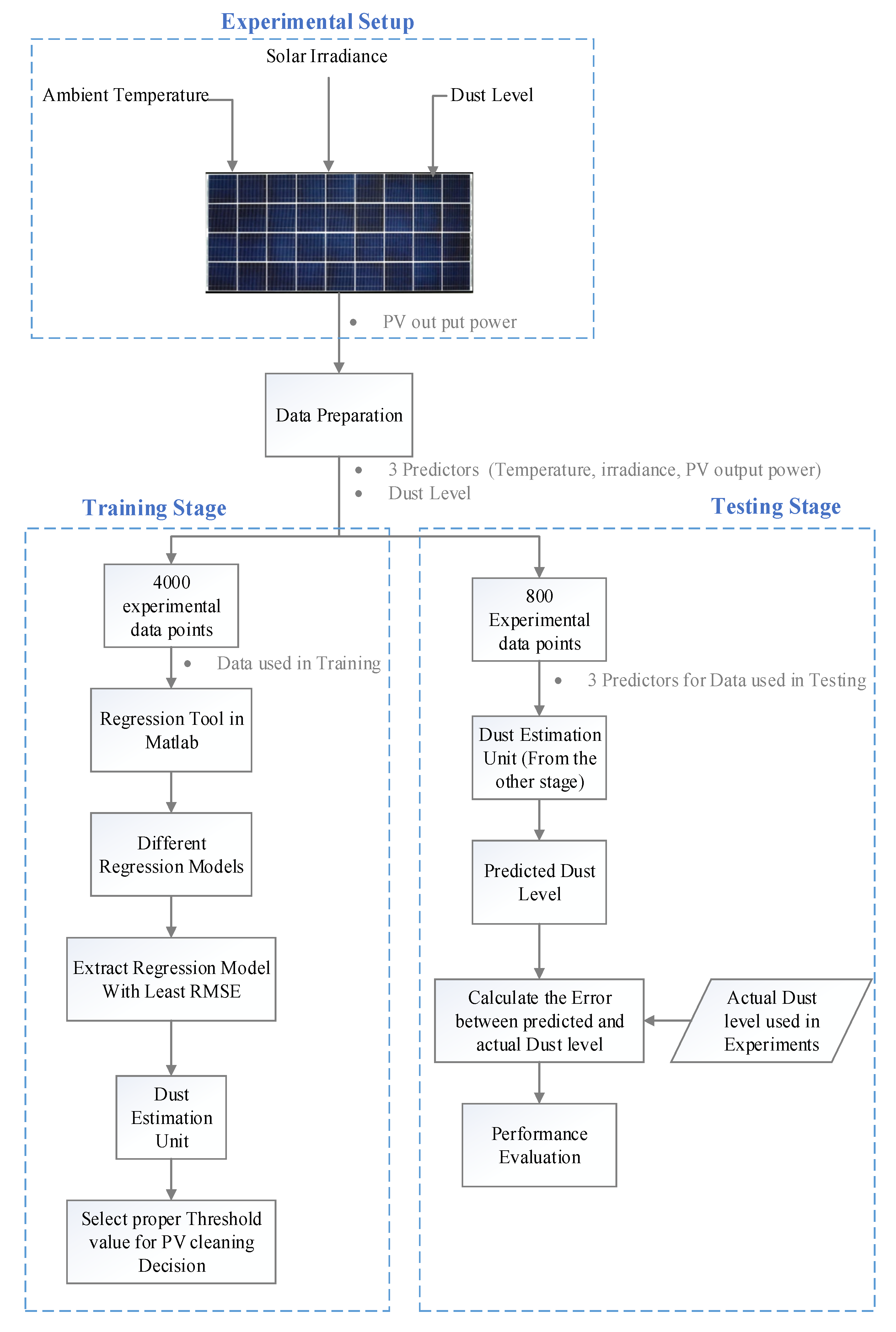

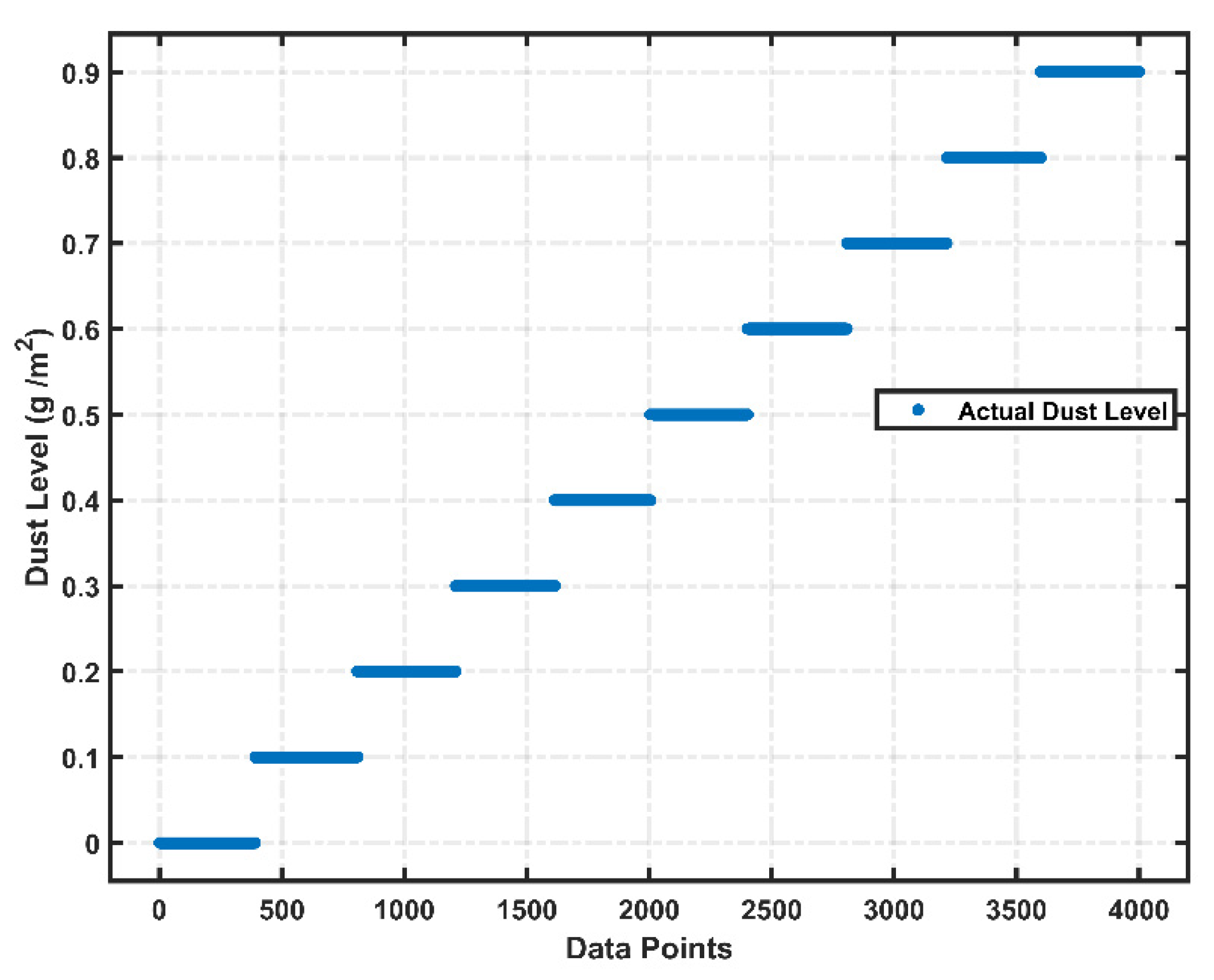
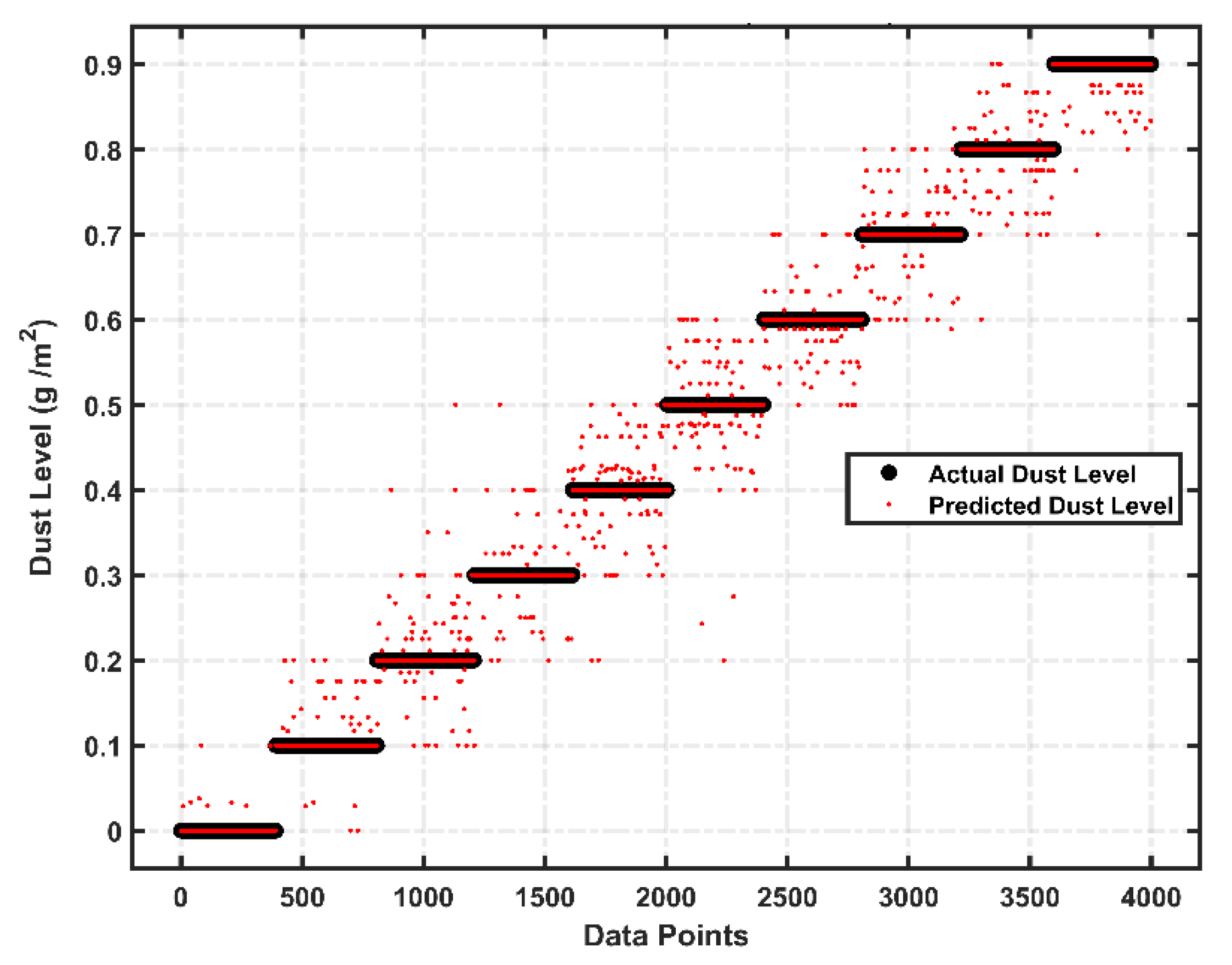
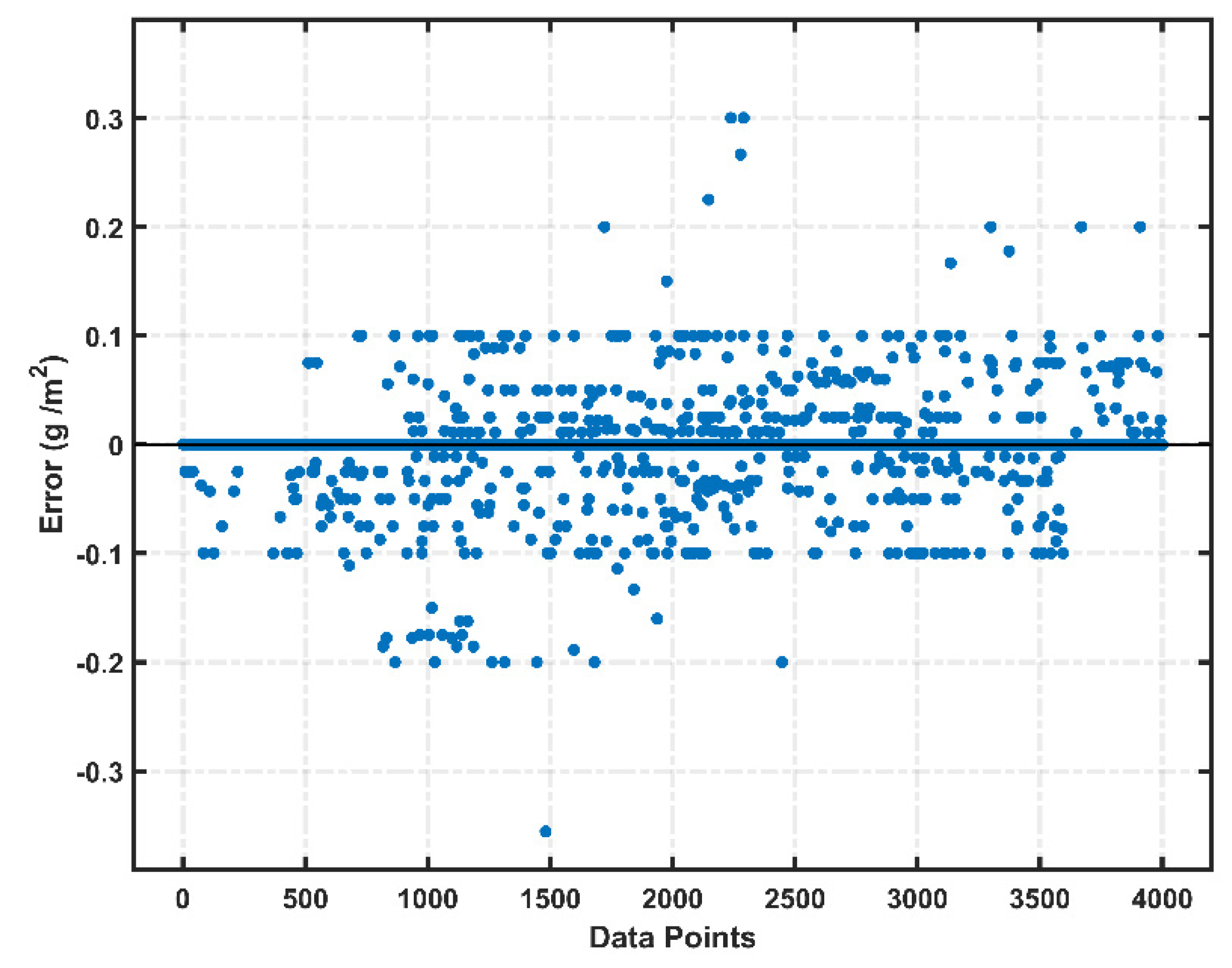
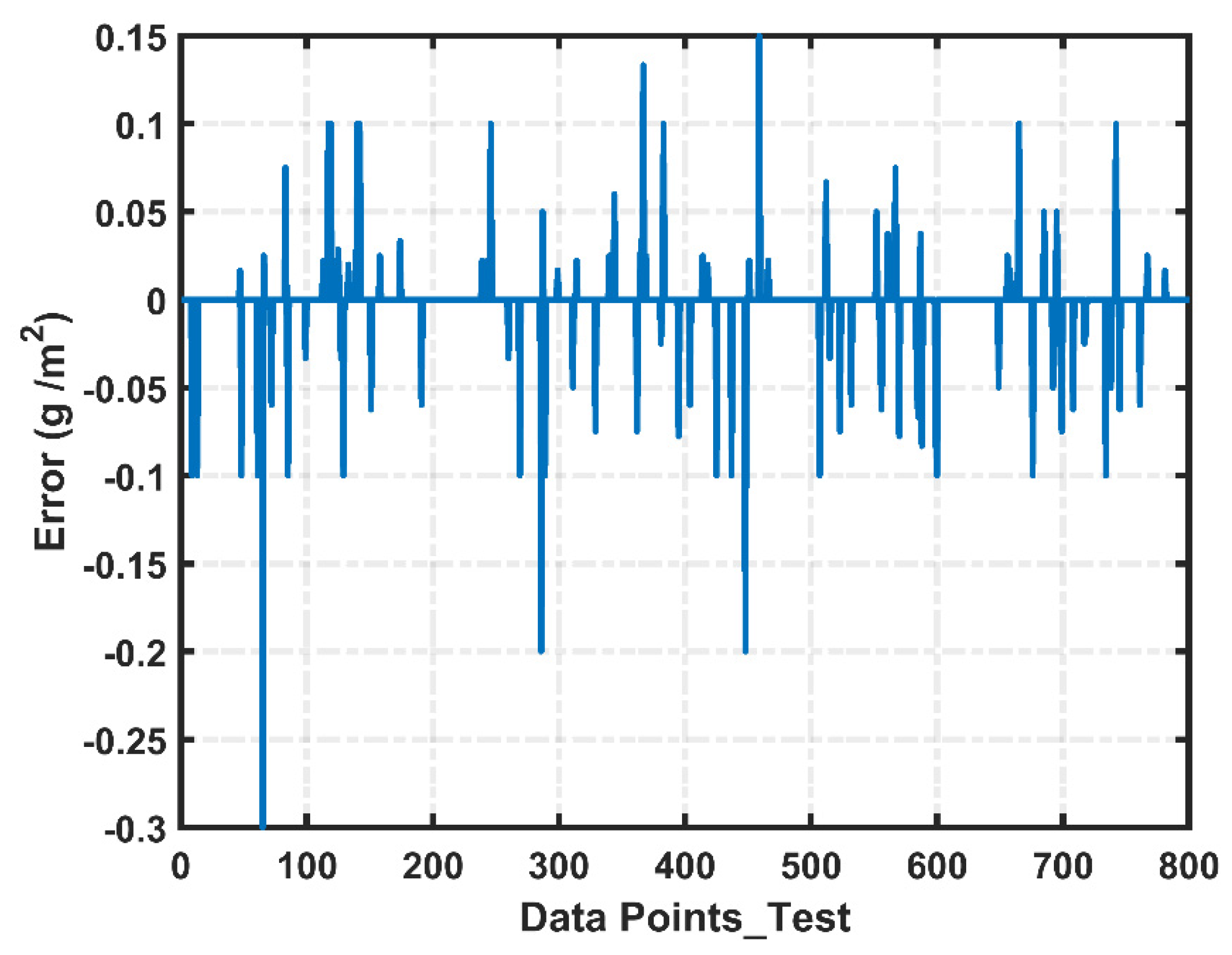
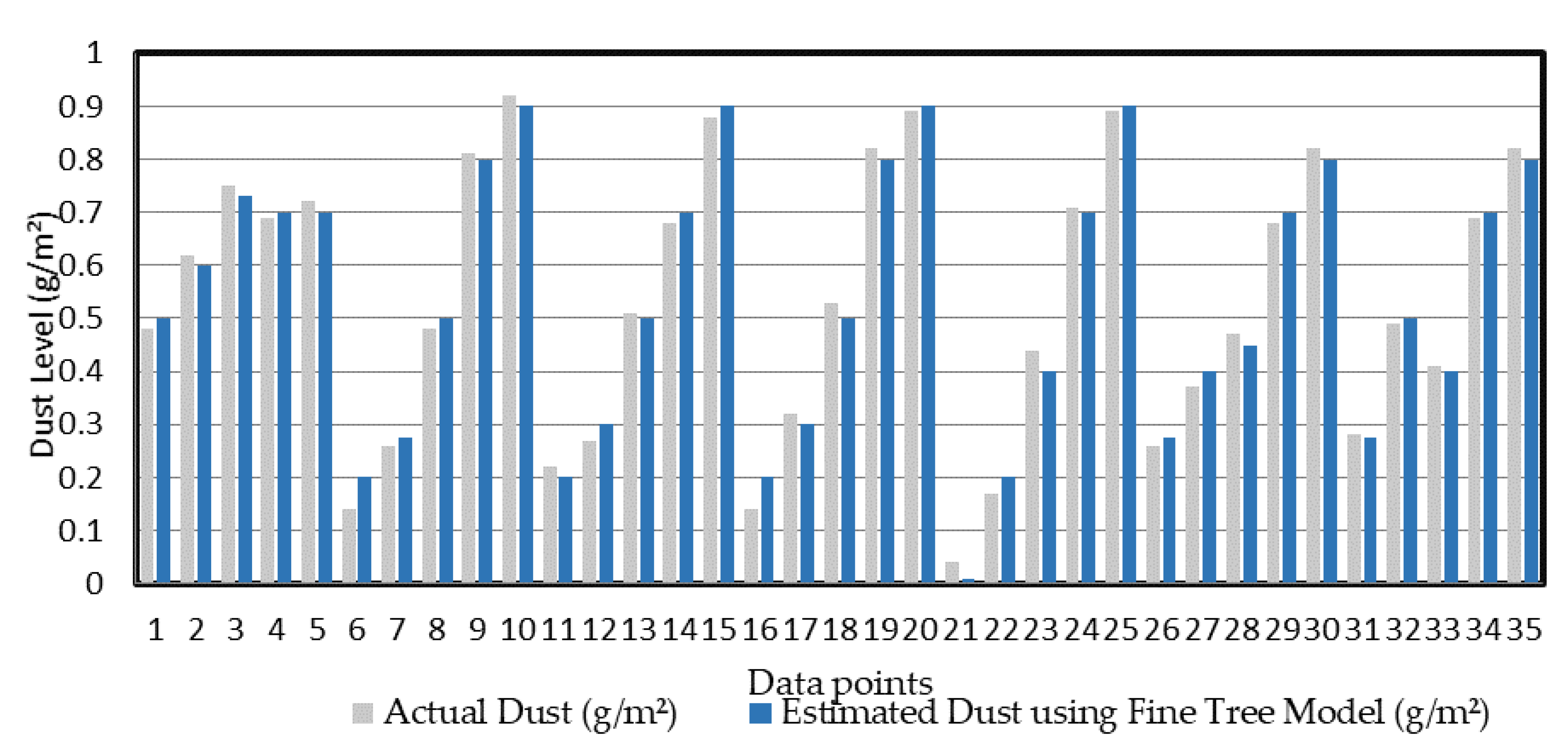
| Specifications | Sun Power Manufacturer |
|---|---|
| Material | c-Si |
| Model | E20/435 |
| Panel efficiency | 20.1% |
| Max Power (W) | 435 |
| Vmp (V) | 72.9 |
| Imp (A) | 5.97 |
| Open-circuit voltage (V) | 85.6 |
| Short-circuit Current (A) | 6.43 |
| NOCT (°C) | 45 |
| Temperature coefficient of Pmax (%) | −0.38 |
| Temperature coefficient of Voc (%) | −0.27 |
| Temperature coefficient of Isc (%) | 0.05 |
| Panel Dimension (mm) | 2067 × 1046 × 46 |
| Solar Irradiance (W/m2) | Ambient Temperature (°C) | Output Power (W) | Dust (g/m2) |
|---|---|---|---|
| 650.9 | 33 | 309.28 | 0 |
| 650.9 | 33 | 285.43 | 0.1 |
| 650.9 | 33 | 182.28 | 0.4 |
| 650.9 | 33 | 112 | 0.6 |
| 650.9 | 33 | 87.37 | 0.8 |
| 536.9 | 33 | 252.39 | 0 |
| 536.9 | 33 | 50.36 | 0.9 |
| 158.8 | 27.36 | 63.64 | 0.1 |
| 516.6 | 35 | 177.11 | 0.3 |
| 382.6 | 39.42 | 140.65 | 0.2 |
| 397.1 | 36.42 | 58.52 | 0.6 |
| Regression Model | Model Type | RMSE (g/m2) |
|---|---|---|
| Linear Regression | Linear | 0.093204 |
| Linear Regression | Stepwise Linear | 0.084241 |
| DT | Fine Tree | 0.026737 |
| DT | Coarse Tree | 0.074296 |
| SVM | Linear SVM | 0.094035 |
| SVM | Medium Gaussian SVM | 0.068671 |
| Ensemble | Boosted Trees | 0.064575 |
| Gaussian Process Regression | Squared Exponential GPR | 0.063416 |
| Gaussian Process Regression | Exponential GPR | 0.057048 |
| Solar Irradiance (W/m2) | Ambient Temperature (°C) | Output Power (W) | Actual Dust (g/m2) | Predicted Dust [Error] (g/m2) |
|---|---|---|---|---|
| 564 | 25.91 | 81.97 | 0.8 | 0.7 [0.1] |
| 536.9 | 36.49 | 124.06 | 0.5 | 0.517 [−0.017] |
| 457.7 | 30.54 | 121.07 | 0.5 | 0.2 [0.3] |
| 310 | 33.71 | 95.38 | 0.4 | 0.425 [−0.025] |
| 650.9 | 32.99 | 104.62 | 0.7 | 0.7 [0] |
| 520.1 | 38.56 | 248.22 | 0 | 0 [0] |
| 338 | 31.82 | 124.64 | 0.1 | 0.175 [−0.075] |
| 158.8 | 36.93 | 44.62 | 0.5 | 0.4 [0.1] |
| 507.4 | 36.611 | 81.33 | 0.9 | 0.9 [0] |
| Solar Irradiance (W/m2) | Ambient Temperature (°C) | Output Power (W) | Dust (g/m2) |
|---|---|---|---|
| 606.36 | 33 | 225.31 | 0.14 |
| 506.18 | 31 | 198.97 | 0.14 |
| 546.1 | 32 | 207.03 | 0.22 |
| 546.1 | 32 | 179.52 | 0.27 |
| 606.36 | 33 | 198.64 | 0.32 |
| 609.8 | 33 | 139.15 | 0.48 |
| 609.8 | 33 | 95.17 | 0.69 |
| 516.8 | 33 | 90.15 | 0.71 |
| 516.8 | 33 | 45.35 | 0.89 |
| 506.18 | 31 | 39.65 | 0.92 |
| Performance Parameters | Fine Tree | ANN |
|---|---|---|
| Sensitivity | 86% | 80% |
| Specificity | 99% | 96% |
| Precision | 98.85% | 95.24% |
| Negative Predictive Value | 87.61% | 82.76% |
| Accuracy | 92.5% | 88% |
| False Alarm | 1% | 4% |
© 2020 by the authors. Licensee MDPI, Basel, Switzerland. This article is an open access article distributed under the terms and conditions of the Creative Commons Attribution (CC BY) license (http://creativecommons.org/licenses/by/4.0/).
Share and Cite
Shaaban, M.F.; Alarif, A.; Mokhtar, M.; Tariq, U.; Osman, A.H.; Al-Ali, A.R. A New Data-Based Dust Estimation Unit for PV Panels. Energies 2020, 13, 3601. https://doi.org/10.3390/en13143601
Shaaban MF, Alarif A, Mokhtar M, Tariq U, Osman AH, Al-Ali AR. A New Data-Based Dust Estimation Unit for PV Panels. Energies. 2020; 13(14):3601. https://doi.org/10.3390/en13143601
Chicago/Turabian StyleShaaban, Mostafa. F., Amal Alarif, Mohamed Mokhtar, Usman Tariq, Ahmed H. Osman, and A. R. Al-Ali. 2020. "A New Data-Based Dust Estimation Unit for PV Panels" Energies 13, no. 14: 3601. https://doi.org/10.3390/en13143601
APA StyleShaaban, M. F., Alarif, A., Mokhtar, M., Tariq, U., Osman, A. H., & Al-Ali, A. R. (2020). A New Data-Based Dust Estimation Unit for PV Panels. Energies, 13(14), 3601. https://doi.org/10.3390/en13143601







